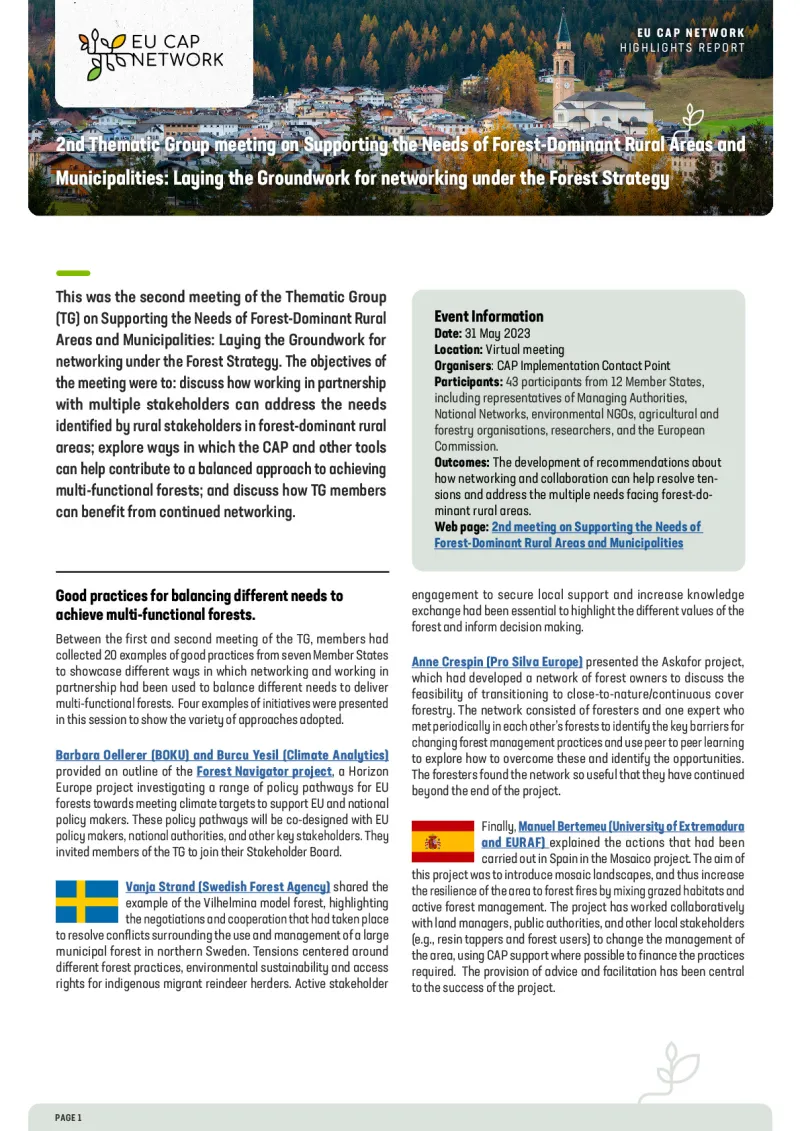Supporting the Needs of Forest-Dominant Rural Areas and Municipalities: Laying the Groundwork for a Network under the Forest Strategy

Forests constitute essential ecosystems within the EU, covering 43.5% of its land area. They provide multiple benefits, not just to forest owners and land managers but also the wider public. As acknowledged in the EU Forest Strategy for 2030 (EUFS), they are important from an economic standpoint as well as environmental in providing essential ecosystem services and social as areas rich with cultural heritage.
Whilst the forestry sector remains important to many rural economies, it is undergoing structural transformation leading to fewer producers, a lower percentage of jobs in primary production held by rural residents, and a lag in the sector’s growth means that its contribution to the EU’s GDP is declining.
Additionally, forest-dominant rural areas and municipalities often face depopulation due to remoteness and lack of adequate services and infrastructure, raising concerns whether the forestry sector is an attractive employment option for young people and whether there will be a sufficient labour force for industry development. Thus, the Long-term vision for the EU's rural areas (LTVRA) highlights the importance of forest-dominant rural areas and the need to stimulate innovation and business development for the rural bioeconomy, new employment opportunities and alternative bio-based products, as well as to protect biodiversity, contribute to the fight against climate change and enhance provision of ecosystem services.
As pointed to in the Forest Strategy, the Common Agricultural Policy (CAP) provides Member States with a mechanism to support forest-dominant rural areas and municipalities, previously through the Rural Development Programmes and now through their CAP Strategic Plans. Whilst the new CAP allows Member States more flexibility in designing their forestry interventions to reduce red tape and stimulate more uptake according to the local context, it is necessary that the target communities are aware, understand, and have the capacity to access this support.
This Thematic Group (TG) had two main strands. First, it provided an opportunity to explore the socioeconomic and environmental needs and issues facing forest-dominant rural areas and municipalities, as well as highlighting the various opportunities that forests bring to the people who live and work in our forests. The TG explored whether and how these issues may be addressed within the context of a new network, and laid the groundwork for the potential development of a network by identifying which stakeholders need to be involved and how to bring them together in a EUFS network to tackle these issues. Second, it focused on what the CAP can do to support their needs and enhance forest-related opportunities and benefits.
The proposed objectives of this TG were to:
- Identify needs and key issues faced by forest-dominant rural areas and municipalities;
- Share experiences between actors to identify challenges and barriers to getting their voices heard in relation to addressing their needs / issues;
- Explore what the added benefit of coming together as a network might be;
- Discuss how the CAP may be utilised to support ideas and initiatives to address these communities’ needs and issues;
- Identify gaps in understanding, support, training and access that may affect uptake of various support mechanisms; and
- Build the foundation for increased network linkages between similar areas and stimulate ideas for future engagement.
If you have any question, please contact us at thematicgroup5@eucapnetwork.eu.
We invite you to follow the work of this Thematic Group via our monthly newsletter and our social media (#EUForests & #RuralAreas).
You can find useful resources about this theme further down in this page and in our Publications section.
Thematic Group meetings
1st meeting of the Thematic Group on Forest-Dominant Rural Areas and Municipalities
- CAP Implementation

2nd meeting of the Thematic Group on Forest-Dominant Rural Areas and Municipalities
- CAP Implementation


